I have been, or can be if you click on a link and make a purchase, compensated via a cash payment, gift, or something else of value for writing this post. As an Amazon Associate, I earn from qualifying purchases. Please read my full Affiliate Disclosure for more information.
When it comes to creating a sanctuary that nurtures peace, balance, and minimalism, few styles rival the Japanese bedroom aesthetic. Rooted in centuries-old traditions, this design philosophy emphasizes natural materials, clean lines, and purposeful simplicity. The result is a space that not only looks beautiful but also encourages a calmer, more mindful lifestyle.
From serene tatami mats to sliding shoji screens, Japanese-inspired bedrooms blend functionality with artful design. They invite you to slow down, breathe deeply, and reconnect with what matters most—turning your bedroom into a restful retreat instead of just a place to sleep.
In this guide, we’ll explore sixteen Japanese bedroom ideas that channel the spirit of Zen living. Whether you’re seeking a fully traditional setup or just want to weave subtle Japanese touches into your existing decor, these ideas will help you strike the perfect balance between elegance and tranquility.
1. Embrace Natural Wood Elements for Warmth and Calm
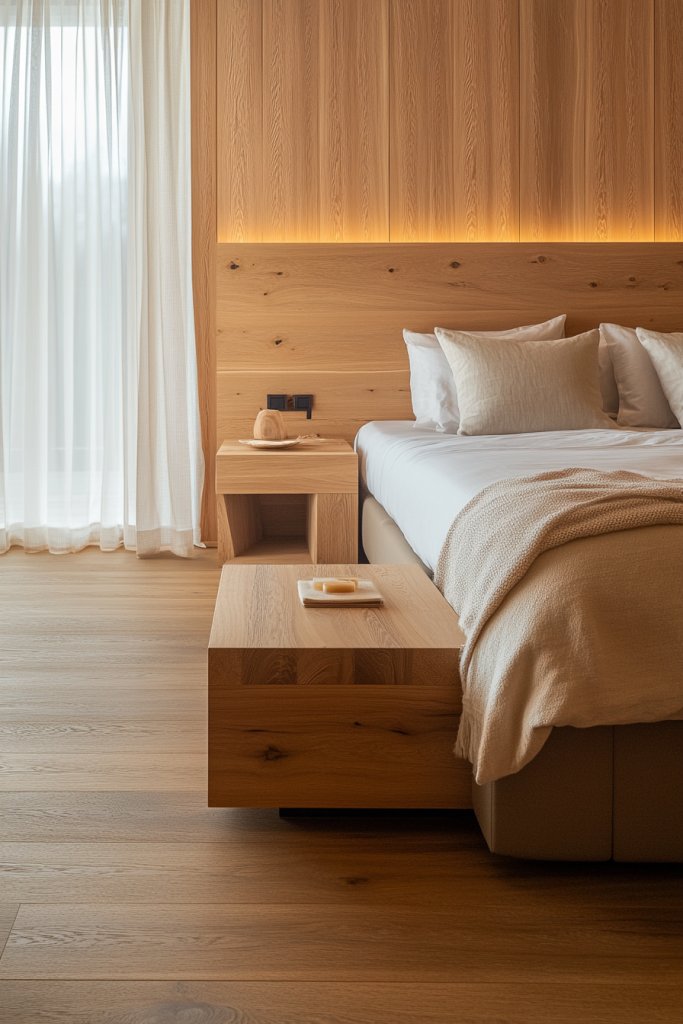
Ever feel like your bedroom is missing that cozy, grounding vibe? Maybe it’s too sterile or cold, making it hard to truly relax after a long day. Incorporating natural wood elements can instantly warm up the space and create a calming atmosphere. It’s like bringing a piece of nature indoors to help you unwind.
Recommended Products to replicate this idea
| # | Preview | Product | |
|---|---|---|---|
| 1 |

|
Mellow Naturalista Classic - 12 Inch Solid Wood Platform Bed with Wooden Slats, No Box Spring... | Check Latest Price |
| # | Preview | Product | |
|---|---|---|---|
| 1 |

|
Art3d Peel and Stick Floor Tile Vinyl Wood Plank 36-Pack 54 Sq.Ft, Deep Gray, Rigid Surface Hard... | Check Latest Price |
Imagine soft, warm-toned wooden furniture—maybe a low bed frame or a simple bedside table—paired with light oak or bamboo flooring. The grain of the wood adds texture and depth, catching the gentle daylight. The natural imperfections and knots in the wood make each piece feel unique and authentic, enhancing the serene vibe. Think of a pale wood finish that reflects light subtly, creating a peaceful glow.
You can opt for darker stained wood for a more dramatic look or keep it light for a breezy, airy feel. Seasonal accents like cozy wool throws or linen bedding complement the warmth of wood tones. If space is limited, incorporate wood through wall panels or decorative accents instead of large furniture pieces. For a more modern aesthetic, combine smooth, polished wood with sleek metal fixtures.
Start by selecting sustainably sourced, untreated wood for eco-friendly choices. Use a mix of furniture, flooring, and decorative elements to create cohesion. Sand and finish the wood with natural oils like linseed or tung for a soft, matte appearance. To keep things simple, choose multi-use furniture with wood finishes, such as a storage bench or a low platform bed. Regularly maintain the wood with gentle cleaning and occasional oiling to preserve its warmth.
Personalize with handcrafted wooden accessories like carved trays, frames, or a bespoke headboard. Layer different wood textures—smooth, distressed, or matte—to add visual interest. Consider adding subtle carvings or engraved patterns for a custom touch. You can also mix wood with textiles in neutral tones to soften the look and make it more inviting.
Embracing natural wood isn’t just trendy; it’s a timeless way to foster calm and connection with nature. Your space will look effortlessly stylish and inviting, perfect for relaxing or meditating. Trust your eye for natural materials—this simple addition can transform your bedroom into a peaceful sanctuary.
2. Opt for Low-Profile Bed Frames for Authentic Minimalism
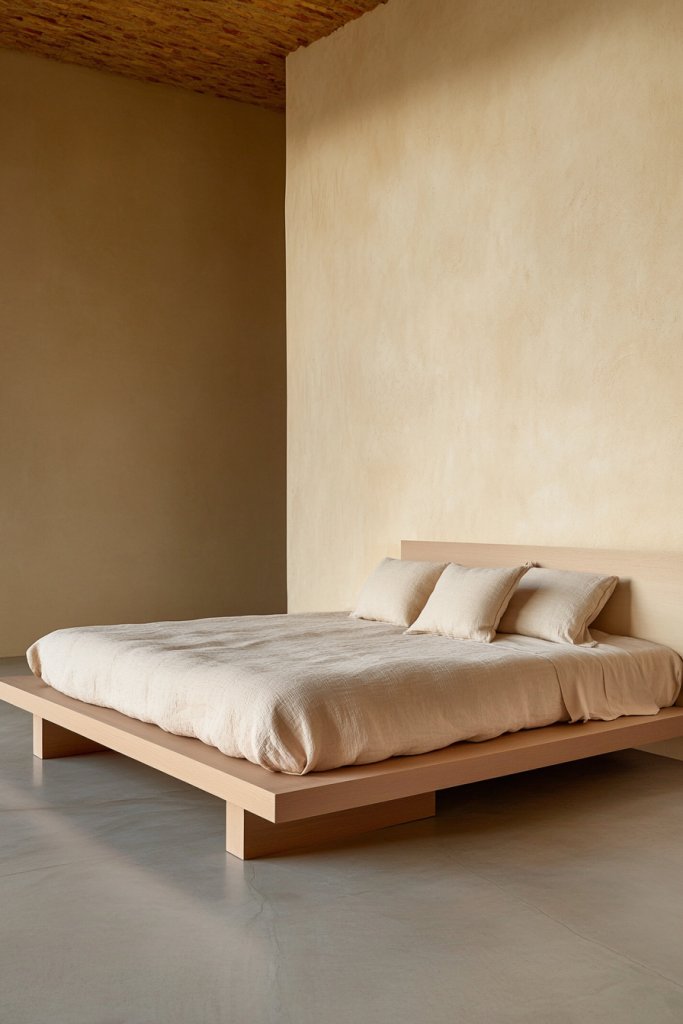
Feeling overwhelmed by bulky, towering beds? Maybe your room feels cluttered or cramped, and you crave a more open, breathable vibe. Low-profile bed frames offer the perfect solution—creating a sense of grounded simplicity that’s both stylish and calming. Who says comfort has to come at the expense of spaciousness?
Recommended Products to replicate this idea
| # | Preview | Product | |
|---|---|---|---|
| 1 |

|
Mellow Naturalista Classic - 12 Inch Solid Wood Platform Bed with Wooden Slats, No Box Spring... | Check Latest Price |
| # | Preview | Product | |
|---|---|---|---|
| 1 |

|
MAXYOYO Japanese Floor Mattress Futon Mattress, 4" Thicken Tatami Mat Sleeping Pad Foldable Roll... | Check Latest Price |
Picture a sleek, minimalist bed frame sitting close to the floor, with clean lines and a slim silhouette. The mattress rests directly on the frame or on a tatami-inspired platform, enhancing the Japanese aesthetic. The absence of a bulky headboard or footboard opens up the room, making it feel larger and more serene. Natural textiles like linen or cotton bedding add softness against the low wood or metal frame.
Choose a frame in natural wood, matte black, or simple painted finishes to suit your style. For a cozy look, layer with a soft cream throw blanket and textured pillows. You can elevate the look with a traditional futon or go ultra-minimalist with just a thin mattress directly on the floor. Adjust height based on personal preference or space constraints—lower is usually better for that Zen aesthetic.
Start by measuring your space to ensure the frame won’t overwhelm the room. Opt for frames with simple, sturdy construction—preferably with a slatted base for breathability. If you’re building one yourself, use lightweight, durable materials like bamboo or plywood. Keep the design low but supportive, and avoid overly ornate details. To keep it authentic, keep the surrounding decor sparse and uncluttered.
Add a custom headboard made from woven bamboo or reclaimed wood for a handcrafted touch. Incorporate layered bedding with textured throws and cushions to add comfort without bulk. Personalize with a small bedside shelf or a floating shelf for nighttime essentials. Use soft lighting like paper lanterns or wall-mounted sconces to complete the zen vibe.
A low-profile bed frame embodies the core of Japanese minimalism—simple, functional, and beautiful. It encourages a clutter-free space that promotes restful sleep and mental clarity. Once you see how spacious and peaceful your room becomes, you’ll wonder why you ever went tall with your bed.
3. Use Neutral Tones and Soft Textures for a Peaceful Palette
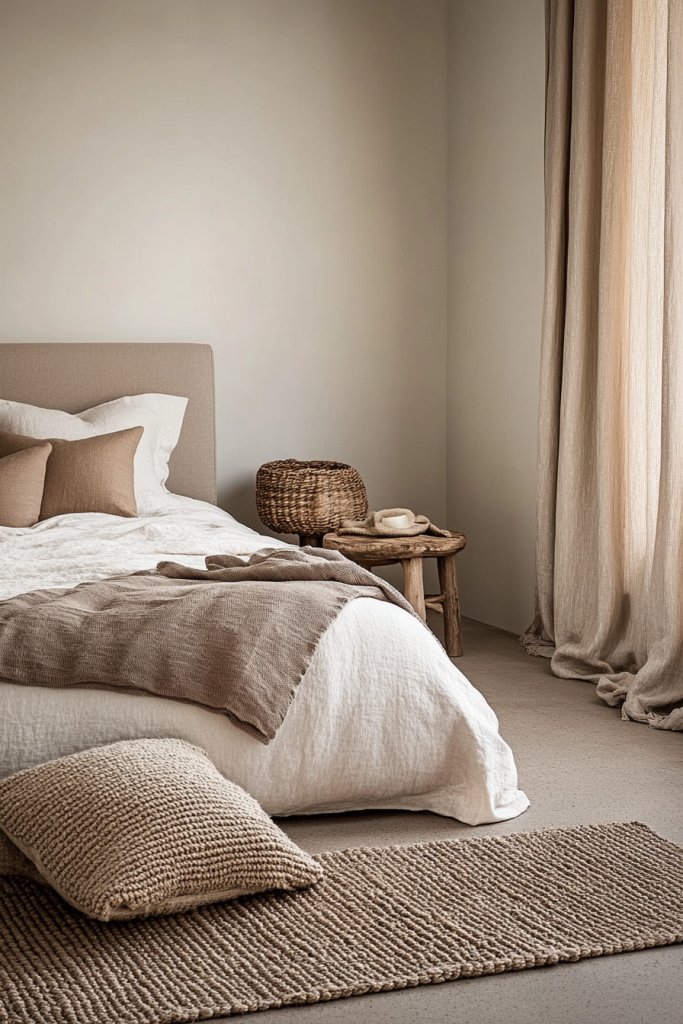
Does your bedroom feel too busy or chaotic? Maybe bright colors and loud patterns keep you from truly relaxing. A neutral palette with soft textures creates a peaceful environment that soothes the mind. It’s like pressing pause on visual noise, inviting calm and mindfulness.
Recommended Products to replicate this idea
| # | Preview | Product | |
|---|---|---|---|
| 1 |

|
SONORO KATE 100% French Pure Linen Sheets, Breathable and Durable Linen King Size Sheets,... | Check Latest Price |
| # | Preview | Product | |
|---|---|---|---|
| 1 |

|
SAFAVIEH Area Rug 9x12 - Natura Collection - Large - Ivory, Handmade Wool Blend, Textured Design,... | Check Latest Price |
Imagine a room washed in shades of cream, beige, and gentle earth tones. Linen sheets, cotton throws, and a soft wool rug add tactile comfort, inviting you to sink in. The textures create depth without overwhelming the senses, while subtle tonal variations keep the space lively yet calming. Light filters softly through sheer curtains, enhancing the tranquil atmosphere.
Mix different textures—think a boucle throw, a woven blanket, and a plush cushion—to add visual interest. For seasonal shifts, layer lightweight fabrics in summer and cozy knits in winter. This neutral base also serves as a versatile backdrop for small decor accents or artwork, which you can swap out easily.
Choose paint or wallpaper in muted tones as your wall backdrop. Opt for bedding in natural fabrics like linen or organic cotton, which improve with age and get softer over time. Incorporate textured textiles through throws, cushions, and curtains for tactile richness. Keep furniture in light or medium wood tones to complement the color palette. Balance light and dark neutrals to avoid a flat look and maintain visual harmony.
Add a touch of metallic or matte black accents for contrast—think picture frames or small hardware details. Incorporate personalized textiles like a handwoven blanket or custom embroidery on pillowcases. Use layered textures and subtle patterns to keep the space engaging but still calming. Remember, less is more—let the textures speak for themselves.
A neutral, textured palette is timeless and adaptable, perfect for creating a peaceful retreat. It encourages relaxation and mindfulness, making your bedroom a true sanctuary. Trust the simplicity—this understated approach highlights your natural beauty and promotes mental clarity.
4. Incorporate Shoji-Style Sliding Doors for Elegant Privacy

Tired of bulky, traditional doors cluttering your space? Want a way to partition your room that’s both functional and stylish? Shoji-style sliding doors offer a delicate balance—providing privacy without sacrificing light or space. They add a touch of authentic Japanese charm to any bedroom.
Recommended Products to replicate this idea
| # | Preview | Product | |
|---|---|---|---|
| 1 |

|
Prime-Line 161791 By-Pass Closet Track Kit, 48 In., 2-Door Hardware, Brass-Plated Pulls (1 Kit) | Check Latest Price |
Envision lightweight, wooden frames filled with translucent rice paper panels gliding smoothly along a track. The soft, diffused light filters through, creating a serene glow. These doors delicately divide spaces without closing them off completely, maintaining an open, airy feel. Their simple yet elegant design complements both modern and traditional decor styles.
Choose from natural wood finishes or painted options to match your aesthetic. For a more contemporary look, opt for slim, sleek frames with frosted or textured panels. You can also incorporate shoji-inspired room dividers made from bamboo or woven materials for a handcrafted touch. Seasonal decor can be added with fabric curtains or layered screens.
Install the sliding tracks at the top and bottom of the doorway, ensuring they’re level for smooth operation. Select lightweight, durable frames that can support rice paper or alternative translucent materials like frosted acrylic or fabric. Regular maintenance involves checking the tracks and cleaning the panels gently. For DIY installation, follow online tutorials or hire a professional for perfect alignment.
Customize with subtle wood stains or painted finishes to suit your room’s color scheme. Add decorative handles or pulls for a personalized touch. Consider layering with sheer curtains or textured fabrics behind the doors for extra privacy or style. Use lighting to highlight the doors’ craftsmanship and create a cozy ambiance.
Incorporating shoji-style sliding doors not only elevates your decor but also enhances your space’s functionality. It’s a simple upgrade that adds elegance and flexibility, making your bedroom feel more Zen and open. Trust this timeless element to transform your environment into a calming retreat.
5. Create a Tidy, Clutter-Free Space with Smart Storage Solutions
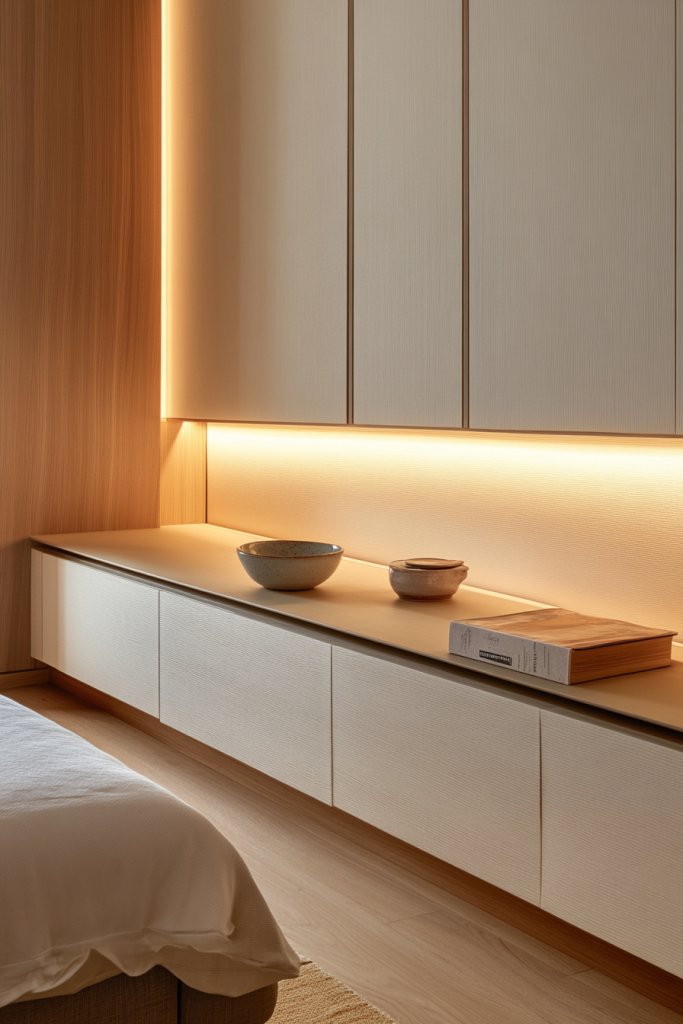
Does your bedroom always feel cluttered no matter how often you tidy up? The chaos of daily life often leads to piles of clothes, accessories, and miscellaneous items cluttering your space. Smart storage solutions help you keep everything organized while maintaining that clean, minimalist aesthetic. Who doesn’t want a peaceful, clutter-free retreat?
Recommended Products to replicate this idea
| # | Preview | Product | |
|---|---|---|---|
| 1 |

|
WOPITUES Wood Floating Shelves Set of 6, Shelves for Wall Decor, Farmhouse Shelf for Bedroom,... | Check Latest Price |
| # | Preview | Product | |
|---|---|---|---|
| 1 |

|
SONGMICS MAZIE Collection - 43 Inches Folding Storage Ottoman Bench, Ottoman Foot Rest, End of... | Check Latest Price |
Imagine sleek, hidden compartments within your furniture—like a bed with built-in drawers or a low cabinet with sliding doors. Think of a minimalist wall-mounted shelf that holds essentials neatly out of sight. The room feels spacious and calm, with every item having a designated place. Soft, neutral-colored storage bins keep things tidy without drawing attention.
Opt for furniture with integrated storage—think platform beds with drawers or benches with hidden compartments. Use decorative baskets or fabric bins for quick access to daily essentials. Consider vertical storage options like wall-mounted cabinets or floating shelves for additional space without cluttering the floor. For smaller rooms, multi-functional furniture becomes your best friend.
Start by decluttering to identify what needs storage. Choose furniture with built-in compartments or install wall-mounted units that blend seamlessly into your decor. Use soft-close mechanisms and sturdy hardware for durability. Incorporate removable or washable fabric bins to make cleaning easier. Keep frequently used items within arm’s reach and less-used items tucked away.
Add labels or tags to bins to organize seasonal clothing or accessories. Use decorative fabric liners inside baskets for a polished look. Incorporate a few open shelves for decorative objects or meaningful keepsakes, keeping most items concealed. Regularly reassess your storage to avoid buildup and keep the space feeling fresh.
A well-organized bedroom boosts your mental clarity and creates a calming environment. Smart storage solutions turn chaos into order, making daily routines smoother. Once you see the difference, you’ll wonder why you didn’t do this sooner—your space will become a true sanctuary.
6. Add Tatami Mat-inspired Flooring for Cultural Authenticity
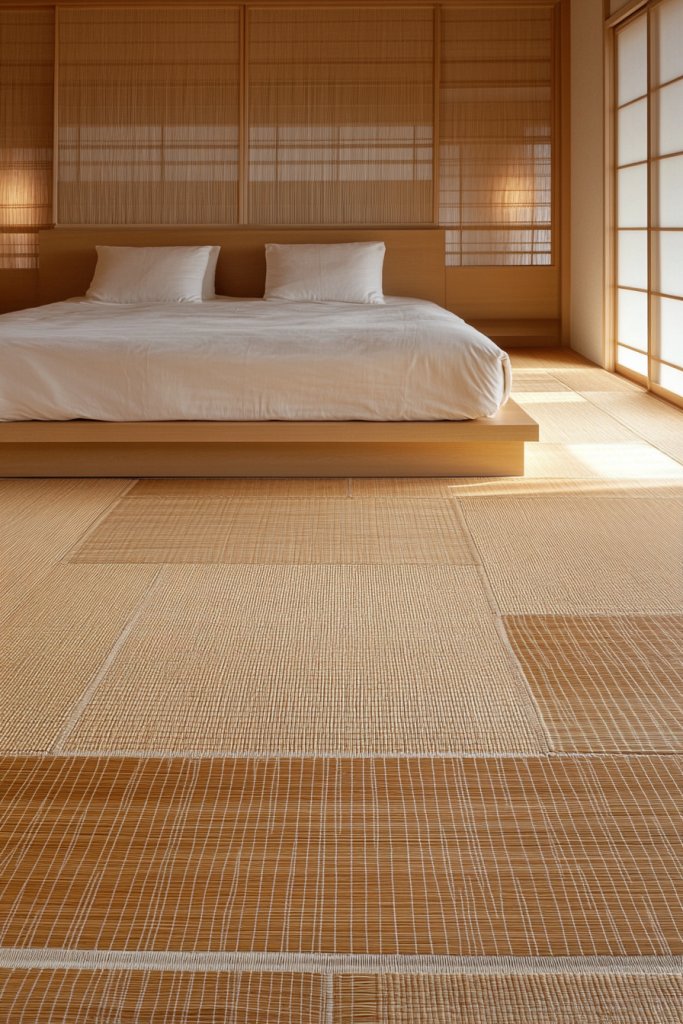
Looking to add a touch of Japanese culture to your bedroom without a full renovation? Tatami mats instantly evoke a Zen-like vibe and tactile comfort, making your space feel authentic and grounded. They’re perfect for creating a calming, meditative environment that invites relaxation. Plus, they’re surprisingly versatile.
Recommended Products to replicate this idea
| # | Preview | Product | |
|---|---|---|---|
| 1 |

|
MAXYOYO Japanese Tatami Mat 100% Rush Grass Portable Folding Mat Futon Mattress Firm Traditional... | Check Latest Price |
| # | Preview | Product | |
|---|---|---|---|
| 1 |

|
Meditation Floor Pillow Set of 2, Square Large Pillows Seating for Adults, Tufted Corduroy... | Check Latest Price |
Picture a soft, woven mat made from straw or foam, laid out in a grid pattern across your floor. The natural, muted tones of traditional tatami—beige, straw, or soft green—bring a sense of harmony. You might layer a small, textured rug on top for added softness or visual interest. The tactile surface invites you to sit or lie down, encouraging mindfulness and stillness.
Use tatami-inspired flooring as a central feature or in specific zones, like a sitting or meditation corner. For a less permanent option, opt for tatami-style rugs or mats that can be rolled up or moved around. Combine with low furniture, cushions, or floor seating for an authentic look. Seasonal accents like a cozy wool blanket or a soft throw can enhance comfort.
Choose durable, eco-friendly tatami mats made from natural materials. Install them directly on a clean, flat surface—some mats are interlocking, making setup straightforward. Regularly vacuum or wipe down to prevent dust buildup. If you’re using rugs, select ones with a similar woven texture and neutral tones. Keep the edges neat with simple border strips.
Customize with layered textiles—think a soft cotton or linen cushion set or a textured blanket. Use minimalist, natural-colored cushions for sitting or lounging. You can even add a small, handcrafted wooden tray for tea or snacks to complement the aesthetic. Keep the area tidy to preserve the clean, Zen look.
Incorporating tatami-inspired flooring transforms your bedroom into a peaceful retreat reminiscent of traditional Japanese spaces. It encourages mindfulness and slow living—perfect for unwinding after busy days. Trust this cultural touch to deepen your room’s serenity and authenticity.
7. Introduce Soft, Ambient Lighting with Paper Lanterns or Dimmer Lamps
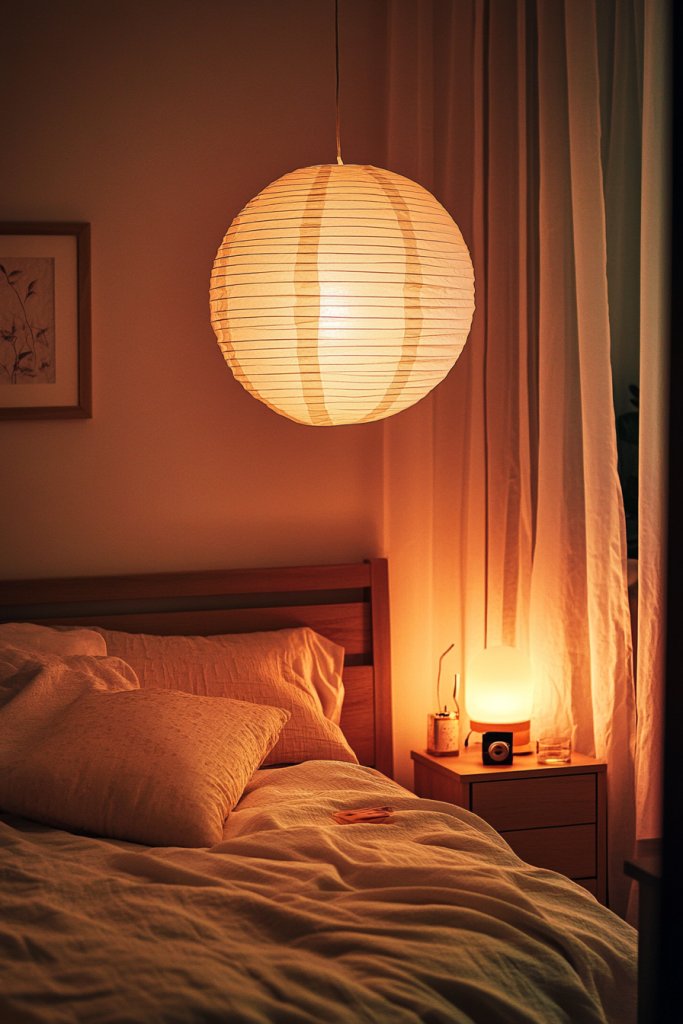
Ever feel like your room is too harshly lit or too dim to relax? The right lighting sets the mood and influences your entire vibe. Soft, ambient light creates a cozy sanctuary, perfect for winding down or meditating. Bright overhead lights can be jarring; gentle illumination is the way to go.
Imagine warm, diffused light emanating from handcrafted paper lanterns hanging from the ceiling or placed on shelves. The soft glow filters through textured rice paper, casting calming shadows across the room. Alternatively, use dimmer-compatible lamps with warm-toned bulbs to adjust brightness effortlessly. The interplay of light and shadow enhances textures and creates a tranquil atmosphere.
Choose traditional Japanese paper lanterns for a cultural touch or sleek, modern dimmable lamps for versatility. Incorporate multiple light sources—like wall sconces, candles, or small table lamps—to layer the lighting. Use warm-colored bulbs to mimic natural sunset tones, which are most relaxing. For different seasons, you might swap out lantern covers or add string lights for a whimsical touch.
Install dimmer switches on main overhead fixtures for adjustable lighting control. Hang paper lanterns from hooks or ceiling mounts, ensuring safety and stability. Choose lamps with soft, warm LEDs or incandescent bulbs for cozy illumination. Keep cords organized with clips or covers to prevent clutter. Regularly clean lanterns and lampshades to maintain their glow.
Personalize lighting with color filters or subtle decorative elements like tassels or fabric wraps on lanterns. Layer lighting by adding small spotlights or uplights to highlight architectural features or textures. Use candles or LED candles for a flickering, calming effect—just make sure they’re safely placed. Incorporate timers or smart controls to automate ambiance shifts.
Thoughtfully layered, soft lighting elevates your bedroom into a peaceful haven. It’s an easy upgrade that instantly makes your space more inviting and relaxing. Trust your instincts—adjusting lighting is one of the simplest ways to influence your mood and create your perfect Zen retreat.
8. Incorporate Nature-Inspired Decor with Minimalist Greenery Alternatives
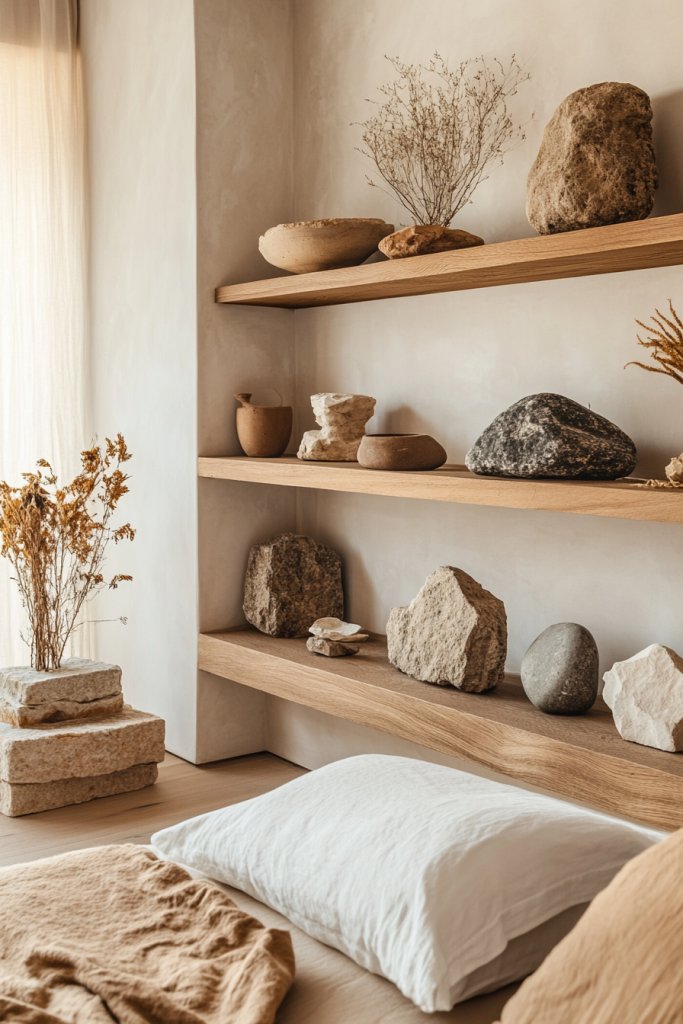
Craving a connection to nature but not a green thumb? Natural decor elements can evoke calm without the upkeep of live plants. Think stone, wood, or dried botanical arrangements that hint at the outdoors. These subtle cues bring serenity and balance to your space without the fuss.
Recommended Products to replicate this idea
| # | Preview | Product | |
|---|---|---|---|
| 1 |

|
Ozzptuu Sandstone Resin Thinker Style Abstract Sculpture Statue Collectible Figurines Home Office... | Check Latest Price |
| # | Preview | Product | |
|---|---|---|---|
| 1 |

|
Green Pampas Grass Boho Bouquet – Exquisite Lavender and Eucalyptus Dried Flower Arrangements... | Check Latest Price |
Picture a textured stone sculpture, a bowl of smooth river pebbles, or a simple arrangement of dried flowers in a handcrafted ceramic container. These elements add tactile interest and earthy tones that complement a subdued color palette. You might incorporate natural wood or cork accents into your furniture or accessories, subtly reinforcing the organic feel. The overall look is understated, elegant, and calming.
Use natural materials in small touches—like a wood tray or stone coasters—paired with soft textiles. Dried botanical arrangements can be placed in simple vases or woven baskets, avoiding lush greenery. Seasonal variations include adding pinecones, dried grasses, or bark accents. Layer different textures and materials to deepen the natural aesthetic.
Select natural decor pieces from local artisans or eco-friendly sources. Incorporate stone, wood, or clay items as accents on shelves or tables. For dried arrangements, choose species that hold their shape and color over time. Regularly dust and clean natural materials to maintain their appearance. Mix and match textures to keep the look fresh and balanced.
Create custom arrangements with personal keepsakes or heirloom objects. Use textured ceramics or sculptural decor to add artistic flair. Combine different natural elements for a curated, layered look that feels organic and intentional. Keep clutter minimal to preserve the calming effect.
Incorporating natural elements in a minimalist way fosters tranquility and a sense of groundedness. It’s a subtle but powerful way to make your space feel more authentic and connected to nature. Trust these simple, tactile touches to enhance your daily mindfulness and serenity.
9. Use Japanese-Inspired Bedding with Simple, Elegant Linens
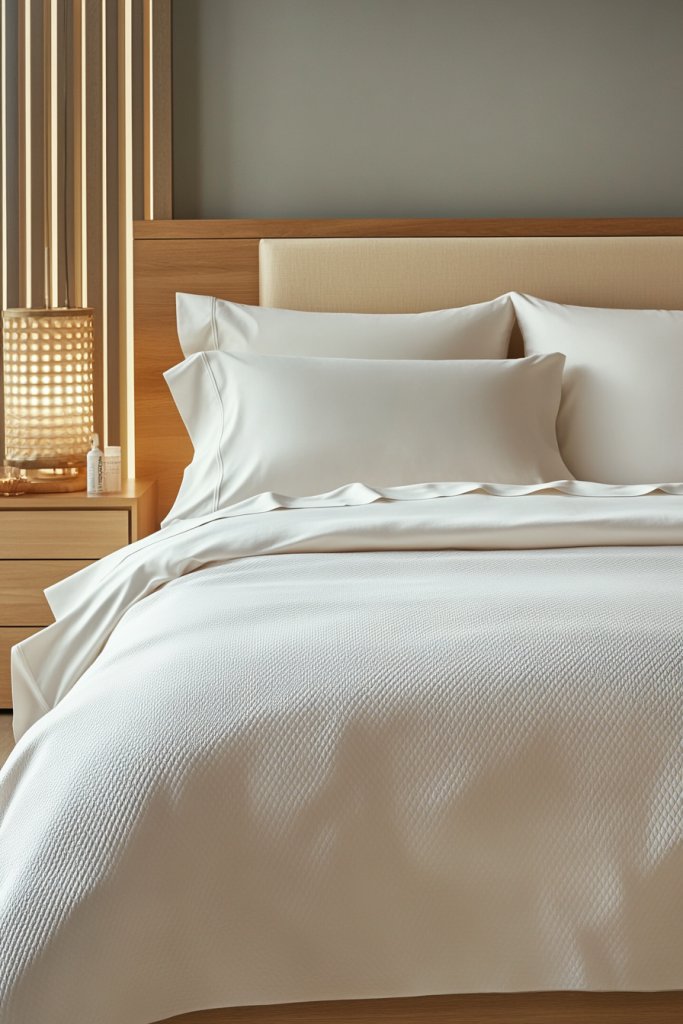
Want to upgrade your bedding but keep things understated and elegant? Japanese-inspired linens focus on simplicity, comfort, and subtle beauty. They transform your bed into a calming centerpiece that promotes restful sleep and relaxation. Who doesn’t want that?
Recommended Products to replicate this idea
| # | Preview | Product | |
|---|---|---|---|
| 1 |

|
California Design Den Natural 100% Cotton Sheets Queen Size Bed Set - Soft 400 Thread Count... | Check Latest Price |
| # | Preview | Product | |
|---|---|---|---|
| 1 |

|
Bedsure Duvet Cover Queen Size - 3 Pieces Prewashed Cotton-Like Extra Soft Bedding Set, Includes... | Check Latest Price |
Imagine crisp, white or soft beige sheets made from breathable cotton or linen. The bedding features minimal stitching or embroidery, emphasizing clean lines. A simple, textured duvet cover or a lightweight quilt adds tactile interest without clutter. Layer with a few well-chosen cushions or throws in neutral tones to enhance comfort.
Opt for natural fabrics that soften over time, like organic linen or bamboo-derived textiles. Keep patterns subtle or nonexistent—solid colors or very fine, understated patterns work best. For seasonal variation, swap lightweight linen in summer with cozy cotton or wool blends in winter. Incorporate textured accents like a woven throw or a silk pillowcase for a luxe touch.
Choose high-quality, natural fiber bedding that ages gracefully. Keep the color palette neutral to maintain a calm, cohesive look. Wash with eco-friendly, gentle detergents to preserve fabric integrity. Use simple, elegant pillow covers and duvet closures—nothing too fussy. Maintain a tidy, uncluttered bed for maximum serenity.
Add personal touches with handcrafted pillowcases or embroidered details. Use a combination of textures—smooth silk with coarse linen—to create visual depth. Incorporate a signature scent with natural linen sprays or essential oils on your linens. Regularly rotate or refresh your bedding to keep the space feeling inviting.
Beautifully simple bedding anchors your bedroom’s calm aesthetic. It’s a subtle luxury that encourages you to unwind and get a good night’s sleep. Trust the timeless elegance of minimalist linens—your sleep sanctuary will thank you.
10. Integrate Floor Cushions and Zabuton for Versatile Seating
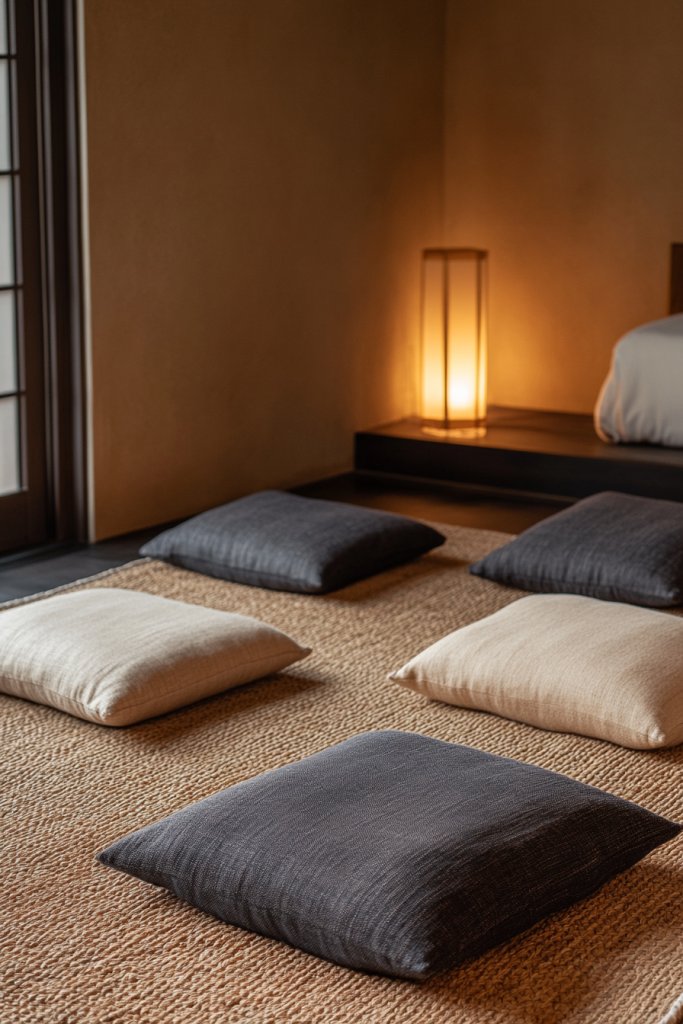
Tired of bulky furniture taking up precious space? Want a seating option that’s flexible, cozy, and true to Japanese tradition? Floor cushions and zabuton provide an inviting, minimalist alternative that promotes mindfulness and simplicity. Plus, they’re easy to move around.
Recommended Products to replicate this idea
| # | Preview | Product | |
|---|---|---|---|
| 1 |

|
Meditation Floor Pillow Set of 2, Square Large Pillows Seating for Adults, Tufted Corduroy... | Check Latest Price |
| # | Preview | Product | |
|---|---|---|---|
| 1 |

|
Florensi Yoga Cushion & Meditation Mat Bundle - Gray, Round Velvet Cover - Buckwheat Pillow &... | Check Latest Price |
Imagine a cluster of plush, neutral-colored cushions arranged on a tatami mat or wooden floor. They come in soft fabrics—cotton, linen, or wool—and are shaped for comfort. When not in use, they can be stacked or stored away, maintaining the room’s clean lines. Their presence creates a casual, welcoming vibe, perfect for meditation or relaxed reading.
Choose cushions in muted tones or subtle patterns to blend seamlessly with your decor. Layer different textures to add visual interest—think rough woven covers or smooth silk. For seasonal changes, swap out covers for warmer fabrics in winter or lighter ones for summer. Use a small side table or tray nearby for snacks or tea.
Select cushions that are firm enough for sitting but soft enough for lounging. Place them on clean, flat flooring—whether tatami, wood, or concrete. Keep them in a corner or near a window to create a dedicated relaxation zone. Store extras in a nearby basket or chest when not in use. Regularly fluff and rotate for even wear.
Personalize with embroidered or hand-dyed covers for a unique touch. Mix and match different sizes and shapes—square, round, or rectangular—for visual variety. Incorporate a small, portable table or a low bench for added functionality. Use decorative trims or tassels to add subtle details.
Floor cushions and zabuton turn your space into a versatile, cozy retreat. They promote a relaxed, unpretentious lifestyle and encourage mindfulness. Once you experience how inviting and adaptable they are, you’ll wonder why you ever relied on traditional furniture.
11. Incorporate a Small Zen Rock Garden or Sand Tray for Meditation
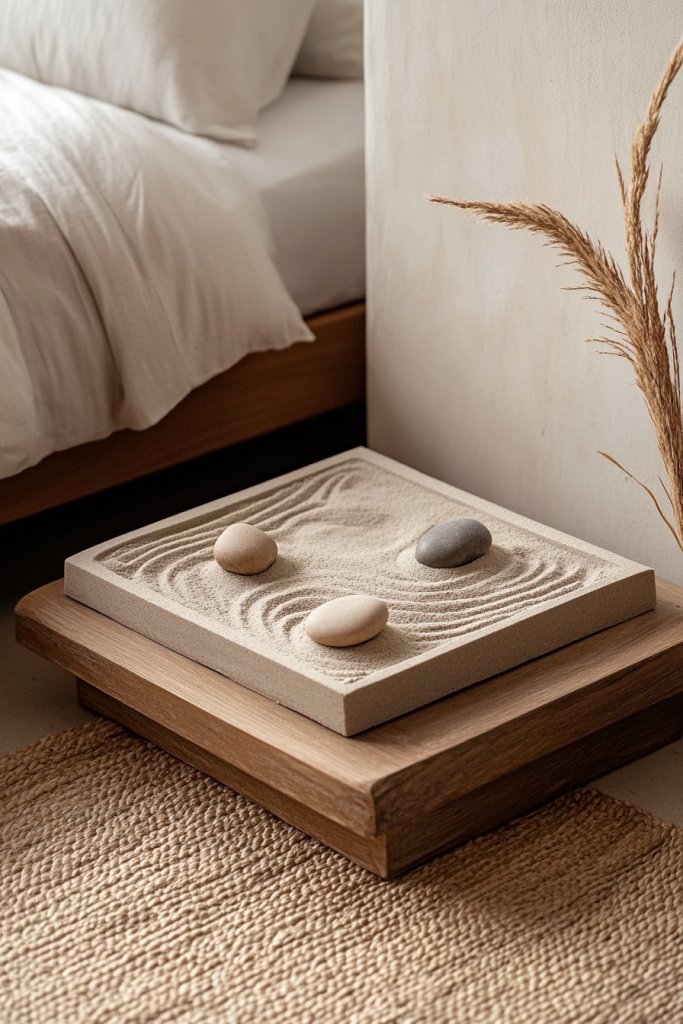
Searching for a focal point that encourages calm and mindfulness? A small Zen rock garden or sand tray is perfect for meditative practices and adds a zen aesthetic to your bedroom. It’s a tactile way to reduce stress and center your thoughts in a busy world.
Recommended Products to replicate this idea
| # | Preview | Product | |
|---|---|---|---|
| 1 |

|
Play Therapy Sand Tray Basic Portable Starter Kit with Tray, Sand, and Miniatures | Check Latest Price |
| # | Preview | Product | |
|---|---|---|---|
| 1 |

|
Truper 31353 Tru Built 48-Inch 14 Teeth Welded Bow Rake, Wood Handle | Check Latest Price |
Imagine a shallow wooden tray filled with fine sand, carefully raked into patterns that evoke ripples or waves. Small stones or pebbles are arranged thoughtfully, symbolizing mountains or islands. The tactile experience invites you to focus on the process, calming your mind. The minimal setup complements a clean, serene space, adding a natural element that’s both beautiful and functional.
Use different materials—white sand, black gravel, or colored stones—to match your decor. Incorporate miniature sculptures or symbolic objects for deeper meaning, but keep them simple. You can add a small, handcrafted wooden rake for shaping the sand—making it part of the ritual. Seasonal touches like dried flowers or moss can add subtle variation.
Choose a shallow, durable tray or container that fits your space. Fill it with clean, fine sand or gravel, and set it on a stable surface—like a low table or shelf. Rake patterns regularly to maintain the calming effect. Keep the area clean and dust-free, and replace the sand periodically. Use it as a daily ritual to focus and reset your mind.
Personalize your Zen garden with meaningful stones, crystals, or symbols. Add a small, decorative cloth underneath the tray for visual softness. Incorporate a gentle scent like sandalwood or cedar nearby to enhance the sensory experience. Keep the setup simple but intentional—less clutter, more calm.
A Zen rock garden or sand tray turns meditation into a beautiful, tactile experience. It’s a small but powerful addition that promotes mindfulness and tranquility. Trust this simple ritual to help clear your mind and foster a peaceful lifestyle.
12. Use Minimalist, Functional Nightstands with Clean Lines
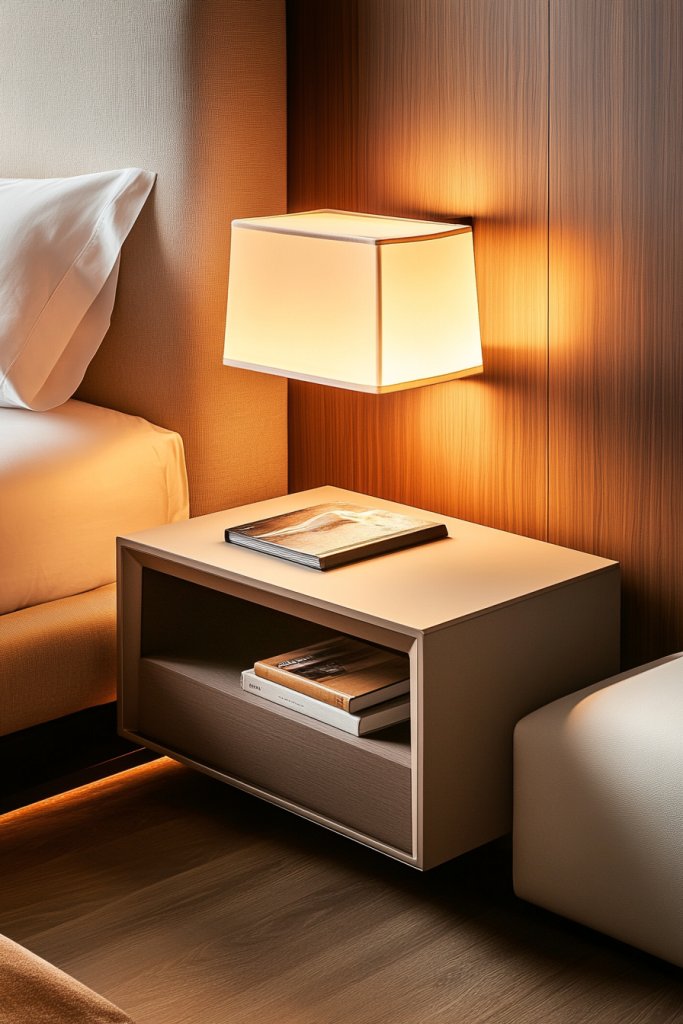
Cluttered nightstands can ruin the calm of your bedroom. You want a piece that’s practical yet unobtrusive, blending seamlessly into your minimalist aesthetic. A sleek, functional nightstand with clean lines keeps essentials at hand without adding visual noise. Less clutter, more peace—that’s the goal.
Picture a simple wooden or metal nightstand, low to the ground, with a smooth surface and no ornate details. It might have a single drawer or open shelf for storage, keeping your items organized. The design emphasizes functionality and simplicity, complementing your bed and overall decor. Soft lighting nearby highlights the clean lines and understated elegance.
Choose a nightstand in natural wood finishes, matte black, or painted in neutral shades. For a more sculptural look, opt for geometric shapes or asymmetrical designs. Add a small, textured tray or fabric organizer to keep personal items tidy. In small spaces, consider wall-mounted options or floating shelves to save floor space.
Select a nightstand that aligns with your room’s aesthetic and storage needs. Ensure stability and ease of access—ideally at arm’s reach from your bed. Keep its surface clear of clutter, reserving space for essentials like a clock or a favorite book. Regularly check for stability and clean the surface for a polished look. DIY options include repainting or staining to match your decor.
Add a decorative element like a minimalist lamp, a small sculpture, or a textured fabric to soften the look. Use a tray or container to organize small items or chargers. Consider customizing with engraved initials or subtle patterns for a personal touch. Keep the overall look simple to maintain the Zen vibe.
A minimalist nightstand enhances your bedroom’s sense of order and calm. It’s a practical piece that supports your lifestyle while reinforcing your aesthetic. Once you see how well it integrates, you’ll wonder why you ever settled for cluttered surfaces.
13. Opt for Simple, Unadorned Window Treatments to Maximize Light
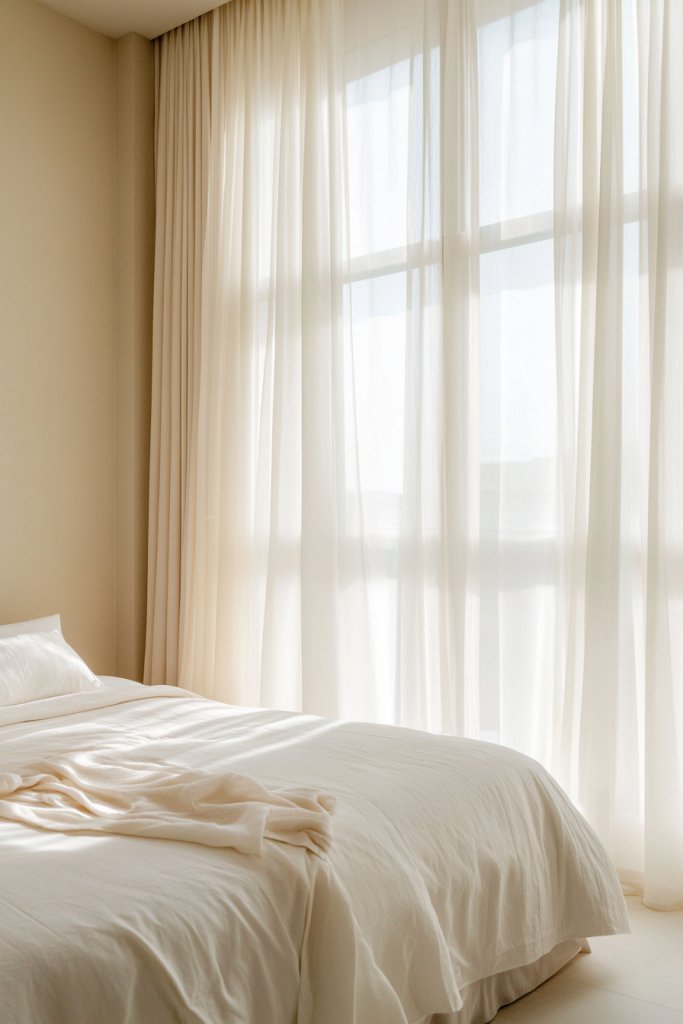
Are heavy curtains or busy blinds blocking natural light from filling your room? You crave a space that feels open, bright, and welcoming. Simple, unobtrusive window treatments like sheer curtains or minimal blinds maximize light while maintaining privacy. Bright spaces foster positive energy and calm.
Recommended Products to replicate this idea
| # | Preview | Product | |
|---|---|---|---|
| 1 |

|
OWENIE Sheer Curtains 84 inches Long 2 Panels Set for Living Room/Bedroom, Rod Pocket Voile Sheer... | Check Latest Price |
| # | Preview | Product | |
|---|---|---|---|
| 1 |

|
AOSKY Cordless Roller Shades Blackout Blinds for Windows Room Darkening Rolled Up Shades with... | Check Latest Price |
Imagine delicate, translucent fabric curtains in soft whites or creams gently billowing with the breeze. They filter sunlight softly, casting a warm, diffused glow across your space. Alternatively, sleek roller or bamboo blinds roll up entirely, allowing full sunlight to pour in during the day. The uncluttered window treatment complements your minimalist aesthetic.
Choose sheer fabrics for a light, airy feel or natural woven materials like bamboo or linen for texture. Use simple tracks, rods, or no hardware at all—just a clean edge or a discreet clip. For privacy at night, layer with blackout blinds or shades that can be rolled away during the day. Adjust your treatments seasonally for maximum light and privacy.
Measure your windows carefully to select the right size and style. Install discreet tracks or brackets that don’t detract from the minimalist look. Use high-quality, lightweight fabrics that are easy to clean and maintain. Keep the hardware simple—think slim, matte finishes. Regularly dust and wash the curtains or wipe down blinds to keep them looking fresh.
Add subtle trims or decorative ties in neutral tones for a personalized touch. Use a combination of sheer curtains with layered shades for versatility. Consider adding a small, textured valance or a fabric band to enhance the look. Keep the overall design simple and functional.
Simple window treatments amplify natural light and elevate your space’s tranquility. They’re an effortless way to keep your room feeling bright and open—trust that minimal is beautiful. Once you embrace simplicity, your room will radiate calm and clarity.
14. Add a Subtle Fragrance with Natural Incense or Essential Oils
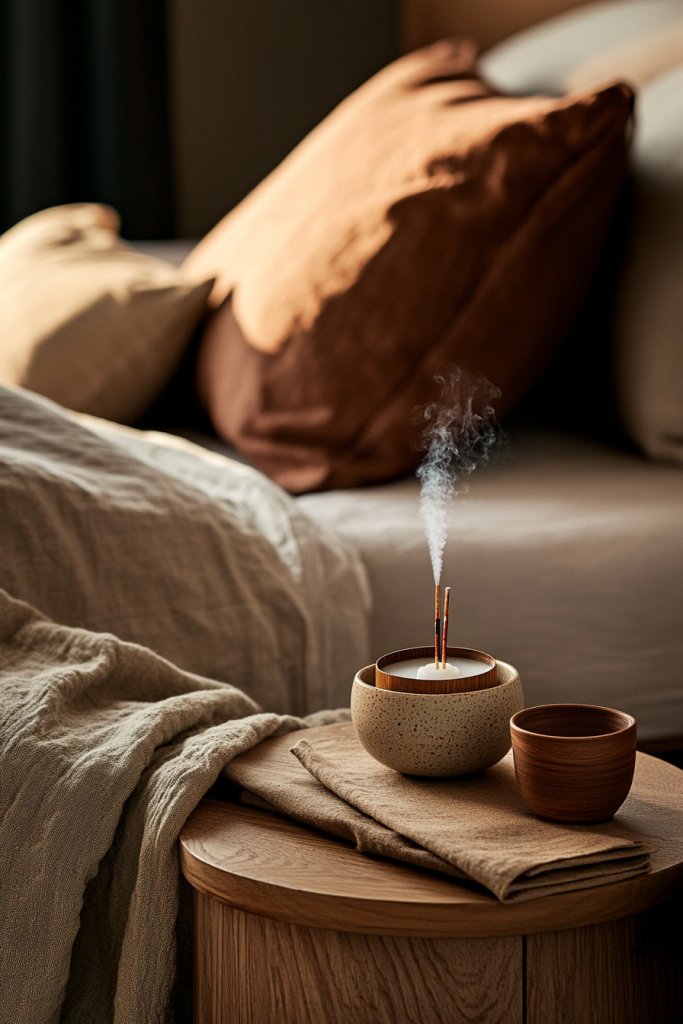
Want to elevate your bedroom ambiance beyond just sight? A gentle, natural fragrance creates an inviting, calming environment. It’s like setting an olfactory mood that relaxes your mind and enhances your space’s serenity. No need for overpowering perfumes—subtlety is key.
Imagine a small ceramic dish or wooden diffuser releasing a faint, soothing aroma of sandalwood, green tea, or cedar. The scent lingers softly, transforming your space into a sanctuary. The minimal setup—like a few drops of essential oil on a diffuser or a stick of incense—adds an elegant sensory layer without clutter. The gentle aroma invites you to breathe deeply and unwind.
Use natural incense sticks, cones, or essential oil diffusers made from ceramics, bamboo, or wood. Choose subtle scents that promote relaxation—think lavender, chamomile, or ylang-ylang. For seasonal variation, switch scents to match your mood or mood shifts. Keep the diffuser or incense holder simple and unobtrusive.
Place diffusers or incense in discreet corners or on a small tray to prevent spills. Use natural, unscented carriers like ceramic or wooden holders to match your decor. Regularly replace or refill the oils or incense sticks for consistent scent quality. Avoid synthetic fragrances—opt for pure, natural oils for the best effect. Store extras in a cool, dark place.
Create your signature scent profile by blending essential oils in a diffuser or rollerball. Add a few drops of oil to a cotton pad tucked in a corner for subtle diffusion. Incorporate small, handcrafted holders or bowls to personalize your setup. Keep the scent subtle but effective—less is more.
A carefully chosen natural fragrance transforms your bedroom into a calming oasis. It’s a simple, affordable way to boost relaxation and improve sleep quality. Trust your nose—your space will feel more inviting and tranquil with just a few drops of nature’s best.
15. Incorporate Traditional Japanese Crafts as Subtle Decor Accents
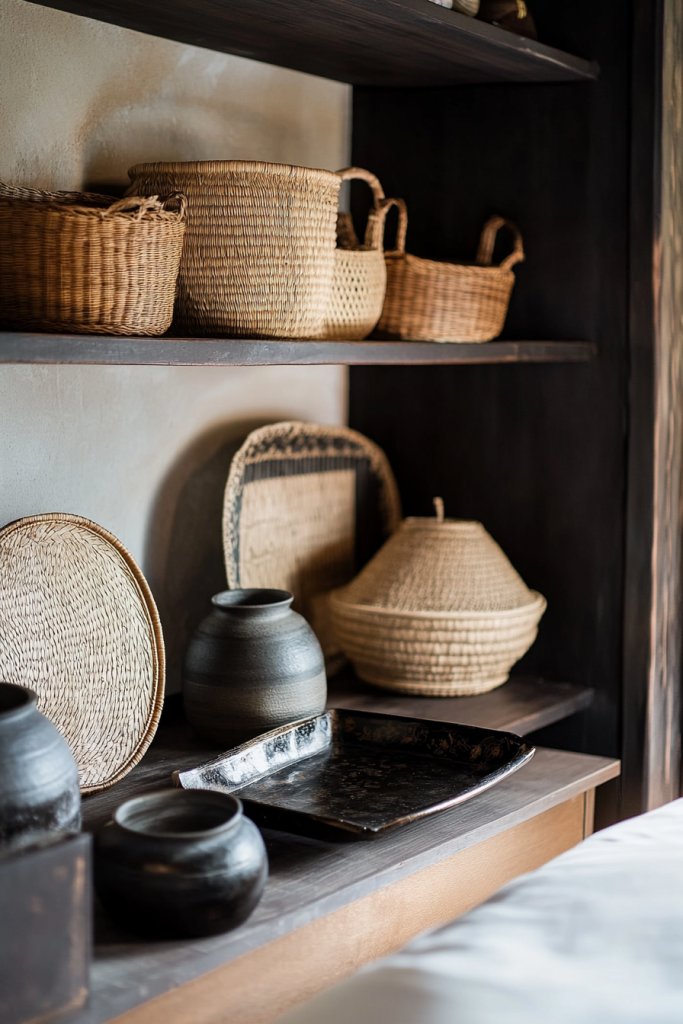
Looking for authentic touches that add cultural depth without overwhelming your decor? Traditional Japanese crafts like woven baskets, handcrafted pottery, or lacquerware bring a subtle elegance to your space. They’re conversation starters and mood setters rolled into one. Plus, they support artisans and sustainable practices.
Recommended Products to replicate this idea
| # | Preview | Product | |
|---|---|---|---|
| 1 |

|
MOUGIGI Handcrafted Ceramic Duck Vase - White Modern Flower Vase with Unique Duck Design - Round... | Check Latest Price |
| # | Preview | Product | |
|---|---|---|---|
| 1 |

|
ZEAYEA Set of 3 Bamboo Basket Tray, Handmade Woven Bread Basket, Stackable Oval Bamboo Serving... | Check Latest Price |
Imagine a beautifully woven bamboo basket holding your rolled linens or a handcrafted ceramic vase placed on a low shelf. The textures and materials evoke a sense of craftsmanship and history. Their understated presence adds visual interest while maintaining a minimalist aesthetic. The natural tones complement neutral palettes perfectly.
Mix different crafts—think carved wooden figurines, lacquered trays, or painted ceramics—for a curated, authentic look. Use them as functional decor—holding jewelry, incense, or small personal items—or as standalone accents. Seasonal swaps, like adding seasonal pottery or woven textiles, keep the decor fresh and meaningful.
Source authentic Japanese crafts from reputable artisans or local markets. Place these items strategically—on shelves, low tables, or within open storage—to highlight their craftsmanship. Keep the surfaces clean and avoid clutter to let each piece stand out. Incorporate care routines specific to each material to preserve their beauty.
Personalize your collection with custom engravings or unique color finishes. Use display stands or shadow boxes for special pieces. Incorporate textures like rough ceramics or smooth lacquer to add tactile interest. These curated accents reflect your appreciation for craftsmanship and cultural beauty.
Traditional crafts add a layer of authenticity and elegance to your decor. They connect your space to a rich cultural heritage while elevating your aesthetic. Trust these timeless pieces to create a warm, inviting atmosphere that celebrates craftsmanship.
16. Keep the Overall Layout Open and Balanced for Serenity
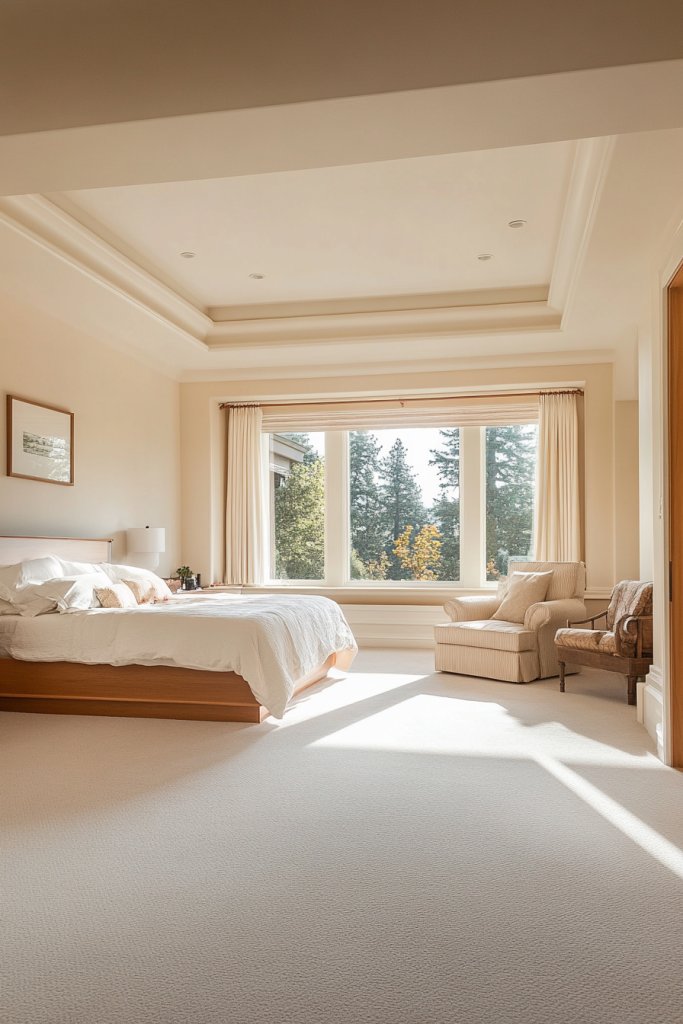
Cluttered, cramped bedrooms can feel overwhelming and stressful. You crave a space that promotes calm and clarity. An open and balanced layout allows for easy movement and visual harmony, making your room a true sanctuary. Less clutter, more Zen—that’s the goal.
Recommended Products to replicate this idea
| # | Preview | Product | |
|---|---|---|---|
| 1 |

|
Mellow Naturalista Classic - 12 Inch Solid Wood Platform Bed with Wooden Slats, No Box Spring... | Check Latest Price |
| # | Preview | Product | |
|---|---|---|---|
| 1 |

|
SONGMICS MAZIE Collection - 43 Inches Folding Storage Ottoman Bench, Ottoman Foot Rest, End of... | Check Latest Price |
Picture a spacious room with furniture arranged to maximize flow. The bed is placed centrally or against a wall with plenty of open space around it. Low-profile furniture and minimal decor keep the sightlines clear. The balance between furniture and empty space creates a peaceful, uncluttered environment. Soft lighting and neutral tones complete the serene picture.
Arrange furniture to create symmetry or asymmetry depending on your style—symmetry promotes order, while asymmetry adds interest. Use multi-purpose furniture to save space and avoid overcrowding. Leave room for natural pathways, and avoid blocking windows or doors. Seasonal adjustments may involve swapping larger furniture for lighter, more open pieces.
Start by measuring your space and planning your layout on paper or with software. Keep larger furniture pieces low and simple, avoiding ornate or bulky items. Use open shelving or storage to keep clutter hidden yet accessible. Regularly reassess the layout, removing unnecessary items to maintain spaciousness. Use visual balance—distribute decor evenly and avoid crowding one corner.
Incorporate a few statement pieces—like a sculptural chair or unique artwork—placed thoughtfully to create focal points. Keep surfaces clear of excess items, only displaying meaningful objects. Use rugs or textiles to define zones without crowding the space. Maintain a clutter-free flow to support mental calm.
An open, balanced space fosters tranquility and mindfulness. It makes your bedroom feel larger and more inviting, encouraging relaxation. Trust that thoughtful simplicity transforms your space into a true retreat for body and mind.
Conclusion
Adopting a Japanese bedroom aesthetic is more than a design choice—it’s an intentional lifestyle shift toward harmony, mindfulness, and simplicity. Each element, from the placement of furniture to the texture of your bedding, plays a role in creating a balanced space that nurtures both body and mind. By embracing natural materials, neutral tones, and uncluttered layouts, you allow your bedroom to become a true sanctuary from the chaos of daily life.
Whether you incorporate just a few touches—like a shoji screen or a bonsai plant—or fully immerse yourself in traditional Japanese design, the essence remains the same: less noise, more calm. With these sixteen ideas as your guide, your bedroom can become not just a place to rest, but a reflection of intentional living, where every detail contributes to a deeper sense of peace.
Last update on 2025-09-21 / Affiliate links / Images from Amazon Product Advertising API
Leave a Reply